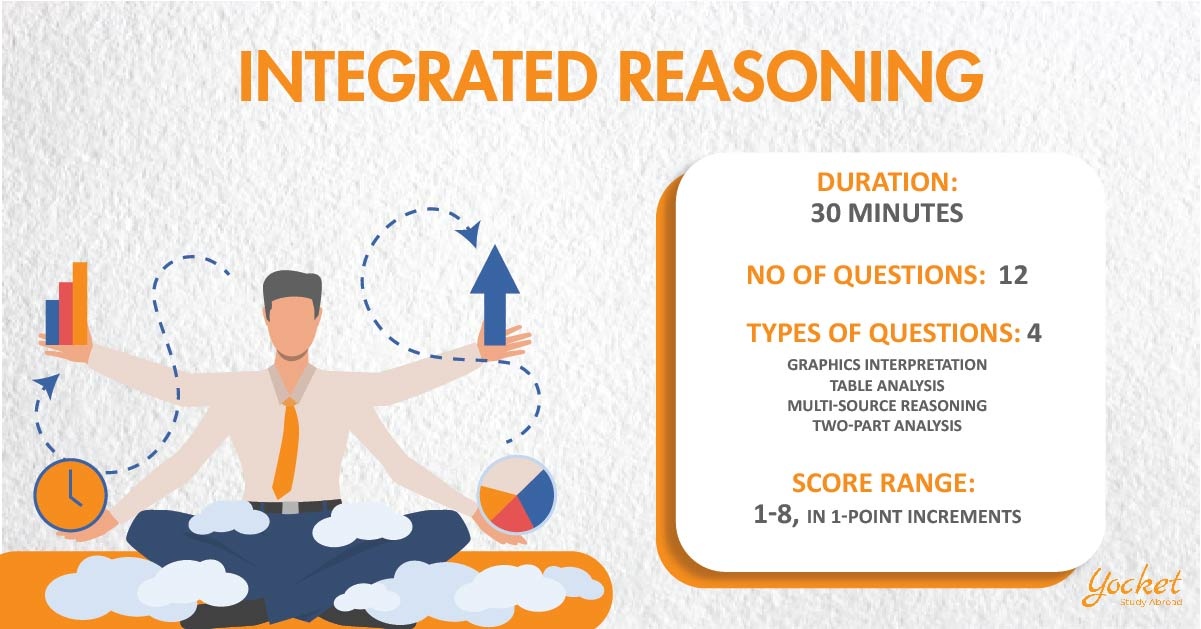In today’s content driven World, data is one of the key factors of every business. Faculties and Business Organisations across the globe stress upon the need of Integrated Reasoning as an essential skill for every Business graduate. Candidates are expected to have an eye to analyze the given data and solve questions. Thus, making IR an important section of the GMAT exam.
The Integrated Reasoning section of GMAT examines your ability to sort massive data, identify relevant information and incorporate strategies to find the desired solution.
Why should you take the GMAT Integrated Reasoning (IR) section seriously?
-
It is an amalgamation of Verbal Reasoning and Quantitative Reasoning skills
-
IR tests your practical approach to realist problems
-
Business schools and Companies emphasize on your real-life data dealing skills
Decoding the GMAT Integrated Reasoning section:
1. No. of Integrated Reasoning questions in GMAT?
Ans. GMAT has 12 questions of Integrated Reasoning
2. How long do you get to solve the section?
Ans. You have a time frame of 30 mins to solve 12 Integrated Reasoning questions of GMAT
3. How is GMAT Integrated Reasoning scored?
Ans. You are scored on a scale of 1-8
REMEMBER: Integrated Reasoning is not a computer adaptive test. The series of questions and their difficulty levels are random.
GMAT Integrated Reasoning section:
What to expect in the GMAT Integrated Reasoning section?
The IR section of GMAT presents you with a variety of data in the form of text, graphs, stats or diagrams. You are required to analyse the data and answer questions accordingly. In this section, you’re expected to answer four types of questions:
-
Table Analysis
-
Graphics Interpretation
-
Two-Part Analysis
-
Multi-Source Reasoning

Let's understand each question type in detail:
-
Table Analysis Questions:
The table analysis questions of GMAT IR section provide you with tabulated data. You are required to analyse the given data to choose a ‘True’ or ‘False’ Or a ‘Yes’ or a ‘No’ answer. Stick to the facts and information presented to you in the question.
Sample Question:

Activity: Tickled by this practice question? Try solving this Table Analysis Question.
-
Graphics Interpretation Questions:
In the Graphic interpretation questions of IR, you are provided with graphs or visuals. Any additional information necessary to answer the question will be mentioned along with the graph. Read the given information carefully to join the dots and answer.
-
In this task, complete the statements by choosing the correct values from the drop-down menu
-
Make mental notes of the scales, marked values and labels of the question to navigate the answer
Sample Question:

Activity: Check how good you’re at interpreting this graphic. Solve this practice Graphics Interpretation Question.
-
Two-Part Analysis Questions:
As the name suggests, in this task, you’re supposed to figure out two answers, one for each step. Meaning, you need to find the two steps involved in solving a problem or two components required to complete a task.
-
To do so, you are presented with options in two columns
-
Analysing the two-parts, mark the best answer for the first part of the question in the first column, and the answer for the second part in the second column
Sample Question:

Activity: Check out how to solve this practice question, by solving the above Two-Part Analysis Questions.
-
Multi-Source Reasoning Questions:
In this Integrated Reasoning section, you’re presented with two or three tabbed questions. Each of these data inferences add up to the subject matter. In order to solve the questions, you’re required to read, understand and evaluate the required data.
-
Remember that the premise of the question remains the same. However, you will encounter variations in the parts of multi-source reasoning questions
-
Data can be given in the form of text, charts, graphs, stats etc.
-
Deduce the answer based on given data, don’t let your knowledge influence your answer
-
Make sure you answer all the parts of the question
Sample Question:

Activity: Puzzled by this Multi-Source Reasoning Question? Try solving it!
Books to refer to for GMAT Integrated Reasoning Section:
As we’ve discussed the types of Integrated Reasoning questions you need to prepare for. Let’s have a peak about IR scoring, Integrated Reasoning mistakes to avoid and look at a few tips on how to tackle Integrated Reasoning section.
How are you scored for the GMAT Integrated Reasoning (IR) section?
As mentioned above, the GMAT Integrated Reasoning section isn’t computer adaptive. The difficulty level of questions is random. However, all the questions have the same point values. There are 12 questions in the section, scored on a 1-8 score scale with a 1-point interval. This also means you can expect 2-4 experimental questions. You cannot identify which of these questions is experimental. Hence, treat all the questions as scored questions.
-
Scoring about ‘5 and above’ is considered to be a good IR score,
-
The IR score is reported separately in the score sheet. This is not a part of the 200 – 800 score.
Studies show that Asian students struggle with the Integrated Reasoning section in GMAT. Many Universities abroad consider the IR score vital during their admission process. Thus, you must pay special attention to this section of the GMAT.
Stay ahead of the pack with these GMAT Integrated Reasoning tips:
-
Attend all the parts and questions of the section.
-
Observe the measures that have been used in the question and in the choice of answers.
-
Familiarize yourself with the basics of graphs, charts etc
-
Practice keeping an ‘error log’, work hard on the type of calculations you’re weak at.
-
Determine the best method of sorting data for various questions and apply them.
-
Avoid getting lost in the presented data.
-
Use the sorting functionality and calculator to save your time.
-
Summarize information wherever necessary.
Three common mistakes of GMAT Integrated Reasoning section you must avoid:
-
Skipping a part or a complete GMAT question: Partial scoring isn’t given in GMAT. Candidates often refuse to take a guess or attend to parts of the question rather than the whole. This affects their score. You either get a complete score on GMAT or you lose the point.
-
Misreading information: Misreading information in haste must be avoided. Patiently read the question and assess.
-
Barking up the wrong tree: This is a common mistake students commit in the Integrated Reasoning section of GMAT. Deep diving into the question for excessive data or unnecessarily calculating various parameters will waste your time. Stick to the questions asked and resolve them.
You might be tempted to take the Integrated Reasoning section lightly. But, don’t, I repeat, DON’T! Test takers can get a great boost on exercising their brains with the IR questions thrown at them. Additionally, Business schools and companies assess your success in the Business with your IR skills. Your data analyzing skills display your talent of an eye for detail.
In the big picture, to be the crème de la crème, focusing all your efforts to prepare only on the Integrated Reasoning section will be a dead loss. Invest time in understanding the overall syllabus and pattern of the exam as well. It is equally important for you to gauge the other GMAT sections, namely, Quantitative Reasoning, Verbal Reasoning and Analytical Writing Assessment. A tight study plan and preparation for GMAT will lead you to be the brightest of the batch!





























